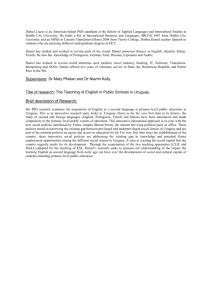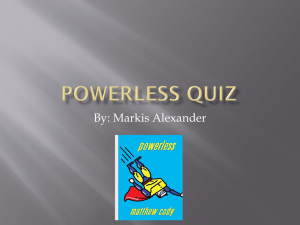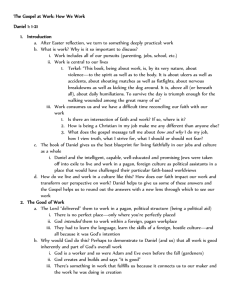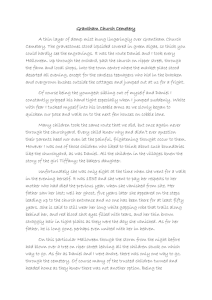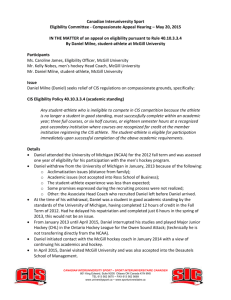Haley Robling Individual Case Study Professor Mulholland 29
advertisement
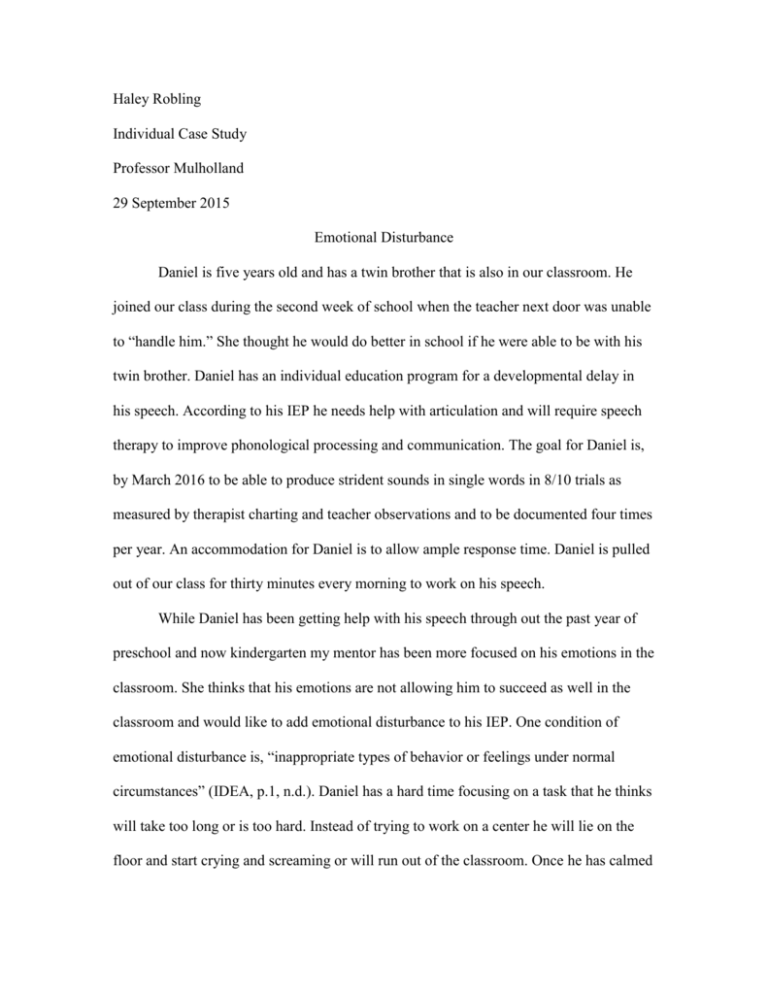
Haley Robling Individual Case Study Professor Mulholland 29 September 2015 Emotional Disturbance Daniel is five years old and has a twin brother that is also in our classroom. He joined our class during the second week of school when the teacher next door was unable to “handle him.” She thought he would do better in school if he were able to be with his twin brother. Daniel has an individual education program for a developmental delay in his speech. According to his IEP he needs help with articulation and will require speech therapy to improve phonological processing and communication. The goal for Daniel is, by March 2016 to be able to produce strident sounds in single words in 8/10 trials as measured by therapist charting and teacher observations and to be documented four times per year. An accommodation for Daniel is to allow ample response time. Daniel is pulled out of our class for thirty minutes every morning to work on his speech. While Daniel has been getting help with his speech through out the past year of preschool and now kindergarten my mentor has been more focused on his emotions in the classroom. She thinks that his emotions are not allowing him to succeed as well in the classroom and would like to add emotional disturbance to his IEP. One condition of emotional disturbance is, “inappropriate types of behavior or feelings under normal circumstances” (IDEA, p.1, n.d.). Daniel has a hard time focusing on a task that he thinks will take too long or is too hard. Instead of trying to work on a center he will lie on the floor and start crying and screaming or will run out of the classroom. Once he has calmed down enough to talk to you he is very reasonable about ways to help him succeed in the classroom. “Support the student’s inclusion. Emotional disturbances, by their nature, can make it difficult for people to build or maintain satisfactory interpersonal relationships. You can support the student with an emotional disturbance in subtle but meaningful ways, especially during group work, cooperative learning activities, peer interactions, and team projects” (Kupper, p.2, n.d). Daniel starts out his center work every morning at his group’s table. At the beginning of the school year he would run out of the classroom if he felt overwhelmed by his peers next to him. After talking to him many times after he had come back into the classroom we decided to give him a desk that he can sit at and work alone. He got to choose the desk and he picked the one in the back of the room that faces the wall. While he still starts off his day at his group’s table he always goes to the back of the room to work by himself. He chooses to move workspaces on his own. While it has helped him stay in the classroom he still becomes frustrated with the work and is unable to focus. He will sometimes just sit in his chair and make a crying noise until a teacher comes to help him. When I sit down with him and tell him step by step what he needs to do he is able to do the work without my help, he just needs the support of me breaking it down and sitting by him. Besides Daniel getting frustrated when it comes to his work he will also get upset when something is not going his way. When this happens he will again leave the classroom or start crying on the floor. Daniel may become upset when he is not called on right away, he has not finished his work, or someone talks when he has been called on. An accommodation that we have made for Daniel is he is able to leave the classroom and sit in the pod area but he is not allowed to go outside. This has worked out well since he is able to calm down and then come back into the classroom when he is ready to explain how he is feeling and ways we can fix the situation. “Follow low-interest activities with high interest activities so that students get a break from difficult or less interesting activities from time to time” (For teachers, p.1, 2014). I think this would be a good accommodation for Daniel. If he does his centers and completes them I think he should be able to choose what he would like to do next. In the morning when we are focusing on reading and writing I think it would be a good idea for him to get to choose the word or letter work he would like to do after completing his centers. This way he may be interested and feel like he is able complete the work that he picked out for himself. I know he is able to complete the work that is given during center times based on his assessments and work he does when he focuses. It’s helping him get past the crying and feeling like it is too much that will help him succeed in the classroom. References For Teachers. (n.d.). Retrieved September 29, 2015. IDEA - Building The Legacy of IDEA 2004. (n.d.). Retrieved September 29, 2015. Kupper, L. (n.d.). Teaching Students with Emotional Disturbances: 8 Tips for Teachers. Retrieved September 29, 2015. His name has been changed.




